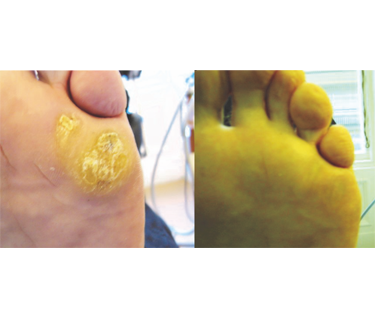



Podiatry Treatments
What is a Podiatrist?
A Podiatrist (the modern word for Chiropodist) diagnoses and treats conditions relating to the foot and lower limb. Both titles are "protected" by the Health Professions Council (HPC), who ensure practitioners have the necessary credentials to practice.
To become a Podiatrist In the UK a practitioner must complete a three or four year full time course that leads to a Bachelor of Science Degree in Podiatry BSc (honours).

At the Biomechanix Clinic we offer a number of podiatry services and treatments, including:
- Calluses
- Corns
- Diabetic and Rheumatoid Treatments
- Dry Needling for Verrucas
- Electrosurgery
- Fungal Nails
- Hard and Dry Skin
- Ingrown Toenail
- Nail Surgery
- Nail Trimming
- Plantar Fasciitis and Heel Pain
- Verrucae
Contact us for more information.
Remy 4 Laser is The Most Effective Treatment for Warts & Verruca
Warts and verruca are small growths on the skin. They are caused by a virus called the human papilloma virus. Warts on the hand and verruca on the feet can be a real pain, but there is really no need to suffer any longer.
Remy 4 Laser treatment offers a fast and effective solution.
There are many ways to treat warts and verruca, but the most effective in terms of results, and time is the Remy 4 laser.
Contact us for more information.


Dry Needling for Verrucas
Dry needling is carried out painlessly under local anaesthetic. A sterile needle is then used to cause a localised trauma to the verruca itself.
The purpose of this is to disrupt the papilli in the verruca and by implanting the virus in the dermal layer allows the bodies immune system to recognise the virus. This stimulates a cellmediated immune response and thus attack the lesion directly. This can result in spontaneous regression in some/all satellite verrucae. By using this technique, instead of many treatments involving chemical cautery or cryotherapy, it may only require one dry needling.
Sucess Rates
At the moment at the last audit the success rate is about 73%, which in terms of verrucas, some of which may have been around for years, is very good. Do not expect this treatment to work overnight, as it can take up to 2 months to show signs of resolution.
Will it be Painful Afterwards?
Some patients may experience slight discomfort after the anaesthetic has worn off. If this occurs, routine doses of your usual painkiller are normally sufficient to reduce the discomfort.
Nail Surgery
Nail surgery is the removal of a problematic piece of nail using a local anaesthesia so that you will feel no pain during the procedure. The nail will be cut back to reduce its width, which will allow the toe to heal (see picture below). A chemical (phenol) will be used to prevent the nail regrowing. Healing normally takes four to eight weeks.
Advantages of Nail Surgery
- You will get less discomfort from the toe.
- You will have less risk of toe infection once you have healed from the surgery.
- You will be able to wear a wider choice of footwear.
Risks and Possible Complications
Every effort is made to minimise the risk of complications. Although they are rare, some of the following may occur:
- Delayed healing or prolonged weeping of the wound.
- Infection may develop after the operation, although removal of the sharp nail portion normally reduces any pre-existing infection.
- Some patients can have adverse reaction to phenol (phenol flare). This occurs in less than 1% of cases.
- Re-growth of the nail occurs in approximately 5% of patients undergoing nail surgery and 10% of those whose whole nail has been removed. The re-growth is often less troublesome than the original problem, but it may be necessary to repeat the procedure.
- Hypersensitivity reaction to the local anaesthetic.

Electrosurgery
It is a procedure which is widely used for the treatment of verrucae and other skin lesions. The procedure takes approximately one hour to complete, and you will need to return in 1-3 days to have your dressing changed.
Healing usually takes between 10-14 days, depending on how much rest you are able to take.
What are the Possible Complications or Risk of Electrosurgery?
In rare cases, a reaction may occur to the local anaesthetic. In a small number of cases the following problems may occur:
- A delay in healing due to infection or other factors, although good hygiene and rest will reduce the chance of this happening.
- A temporary change of sensation or feeling at the place where the injection is given.
- Some scarring after the procedure.

